Headlines and events archive
Displaying 151 - 200 of 1944
You may also find an archive of news published in the media which are related with the Instituto de Astrofísica de Andalucía - CSIC.
Pages

|
14/11/2023 - 15/11/2023
https://www.iaa.csic.es/noticias/meeting-light-pollution-challenges-and-response… Granada |

|
11/01/2024 - 12:30
MOSAIC: the high multiplex and multi-IFU spectrograph for the ELT MOSAIC is the planned multi-object spectrograph for the 39m Extremely Large Telescope (ELT). Conceived as a multi-purpose instrument, it offers both high multiplex and multi-IFU capabilities at a range of intermediate to high spectral resolving powers in the visible and the near-infrared. In this talk I will showcase the key science cases that drive the top-level requirements and the adopted instrument architecture. With a planned first light in... Dr Ruben Sanchez-Janssen |
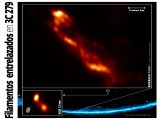
|
26/10/2023
Space interferometry observations reveal helical filaments inside a supermassive black hole's jet stream The Instituto de Astrofísica de Andalucía (IAA-CSIC) leads the observation with the highest resolution and sensitivity of the jet of material emerging from the nucleus of galaxy 3C 279 at almost the speed of light. |

|
24/10/2023 - 25/10/2023
https://www.iaa.csic.es/meetings/andes-technical-meeting Granada |
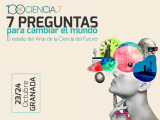
|
23/10/2023 - 24/10/2023
https://www.granadacongresos.com/100xciencia7 Granada |
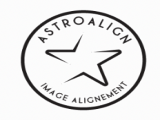
|
14/10/2023 - 14/10/2023
https://indico.iaa.csic.es/event/8/ On line |
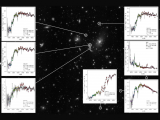
|
18/10/2023
J-PAS: largest mapping of the cosmos begins It will observe hundreds of millions of galaxies from the Javalambre Astrophysical Observatory in order to understand the accelerating expansion of the Universe. |

|
25/01/2024 - 12:30
Stellar population studies in the J-PAS survey The Javalambre Physics of the Accelerating Universe Astrophysical Survey (J-PAS) is a large scale multi-filter survey that has started to observe 8500 deg² of the northern sky with 54 narrow-band filters in the optical range (3500-9600Å). In our Galaxy Evolution group at IAA-CSIC, we aimed at developing and testing methodologies in order to perform stellar populations studies using this kind of data. More precisely, I will introduce our SED-... Dr. Luis Alberto Díaz García |

|
19/12/2023 - 12:30
Fundamental Physics From Ground-Based Gamma-Rays Observations Crucial topics in fundamental physics, such as the existence of new particles, or violations of the Lorentz Invariance arising at the Planck scale, can be effectively tackled in the cosmic environment, by means of ground-based observations in the VHE gamma-ray band. This includes both Particle showers detectors, such as LHAASO and Imaging Atmospheric Cherenkov Telescopes, such as MAGIC, H.E.S.S., or the forthcoming CTA and ASTRI Mini-Array. I... Dr. Giacomo Bonnoli |
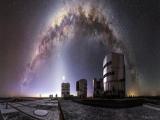
|
02/10/2023 - 02/10/2023
https://indico.iaa.csic.es/event/7/ Granada |

|
16/01/2024 - 12:30
UGR bureocrazy for dummies: PhDs fight back Every year we all wonder about the UGR bureaucracy: did we miss something? how could we have known in advance? Let's face it, it's a mess. To try to help us all, especially those who are just starting, I would like to invite everyone interested to a seminar dedicated to understanding what the PhDs have to go through every year (paperwork related), where to find the proper information, who to contact in case of doubt and how to go through the PhD... Teresa Toscano |
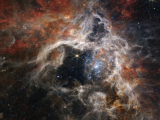
|
27/11/2023 - 01/12/2023
https://www.granadacongresos.com/starform2023 Granada |

|
16/11/2023 - 17/11/2023
https://indico.iaa.csic.es/event/4/ Granada |
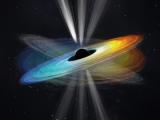
|
27/09/2023
Two decades of observing galaxy M87 show an oscillating jet connected to a rotating black hole The Institute of Astrophysics of Andalusia (IAA-CSIC) participates in the 23-year follow-up of the central supermassive black hole of the galaxy M87. The study reveals that the jet emerging from the centre oscillates, which in turn provides the first evidence of rotation of a supermassive black hole |

|
31/10/2023 - 12:30
Outflows from low to high luminous AGNs Outflows are believed to play a major role in the evolution of galaxies and are said to be ubiquitous within the active galactic nuclei (AGN) population. However, we still lack a comprehensive view of their properties and impact in their host galaxies and the surrounding medium. If we focus on the low luminosity part of the AGN family, in particular in low ionisation nuclear emission-line regions (LINERs), the impact of outflows is still largely... Laura Hermosa Muñoz |

|
03/10/2023 - 12:30
Young massive clusters in the Gaia era After the detection of gravitational waves and the realisation of the wide diversity among core-collapse supernova explosions, Interest in massive stars has been rekindled. Young open clusters are our natural laboratories to explore the lives and deaths of massive stars, and most of our current understanding comes from their study. Until recently, we have been strongly limited by practical difficulties and small number statistics. Most open... Dr. Ignacio Negueruela |

|
26/09/2023 - 12:30
Coloquio SO: Extracting stellar populations and (mainly) emission line information out of S-PLUS photometry We present tests of a new method to simultaneously estimate stellar population and emission line (EL) properties of galaxies out of S-PLUS photometry. The technique uses the AlStar code, updated with an empirical prior which greatly improves its ability to estimate ELs using only the survey's 12 bands. The tests compare the output of (noise-perturbed) synthetic photometry of SDSS galaxies to properties derived from previous (STARLIGHT-based)... Dr. Roberto Cid Fernandes |

|
30/11/2023 - 12:30
SO Colloquium: Studying star-formation in 'collisional' galaxies with MUSE Galaxies in pre- and post-collisional stages are an excellent laboratory to study the evolution of galaxies, particularly the triggering and suppression of star formation on galactic scales before and after such interactions. In order to analyze the star formation triggered in these systems, we started a series of studies on 'collisional' galaxies with available integral field spectroscopy (IFS) observations. We use Very Large Telescope (VLT)... Dr. Victor Mauricio A. Gómez González |

|
21/09/2023 - 12:30
SO Colloquium: Testing black hole structure with very-long-baseline interferometry Black holes hold a tremendous discovery potential, and experiments such as the Event Horizon Telescope and its next generation upgrade could provide important cues about their structure. New physics beyond general relativity can modify the structure of black holes and leave imprints on image features, for instance changing the separation between photon rings or generating additional sets of photon rings. Both cases motivate the study of the... Dr. Raul Carballo |
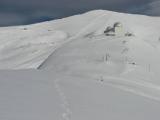
|
11/09/2023
The UGR and the IAA-CSIC join forces to collaborate in climate and ecological research in the high mountains of Sierra Nevada The University of Granada and the Spanish National Research Council (CSIC), through the Institute of Astrophysics of Andalusia (IAA-CSIC), have formalised an agreement with the aim of strengthening cooperation in the field of climate and ecological research in Sierra Nevada |

|
14/09/2023 - 12:30
X-ray emission from Symbiotic Stars: a stellar window to the Astrophysics of AGN Symbiotic stars (SySts) are binary systems in which a white dwarf (WD) accretes material from a red giant star. X-ray studies of SySts reveal an apparent variety of processes which would suggest different origins. In this talk I will briefly review our current knowledge of the X-ray properties of SySts (their classification and physical parameters), in particular I will describe the iconic systems R Aqr and CH Cyg. Finally I will present our... Dr. Jesús Toalá |

|
09/10/2023 - 12:30
SO Colloquium: The demographics of small exoplanets The diversity of the exoplanet population is beyond our imagination. The more than 5000 known exoplanets vastly differ in mass, size, orbital period, dynamics, and host type. Demographic studies, however, aim to find patterns in the population that inform us about their origin, composition, and evolution. Among these features, perhaps the most surprising is the abundance of planets with no analog in the solar system, also known as sub-Neptunes.... Dr. Rafael Luque |

|
16/11/2023 - 12:30
SO Colloquium: The evolution of the accretion process: investigating the protostellar phase to constraints planet formation The accretion process is responsible for the mass building during the star formation phase, but our knowledge of this phenomenon is still not totally understood. On one side, the magnetospheric accretion scenario describes the accretion on pre-main sequence (Class II/III) low-mass stars. However, most of the material is supposed to be accreted during the earliest stages, i.e. the protostellar phase (Class 0/I), when the forming star and its disk... Dr. Fiorellino, Eleonora |

|
09/10/2023 - 11/10/2023
https://www.iaa.csic.es/meetings/sophi-team-meeting Granada |
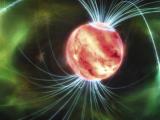
|
05/09/2023
The first detailed image of a radiation belt outside the Solar System is obtained It has been detected around a brown dwarf, a type of cold, low-mass substar. Published in Science, the image evokes the well-known belts of the Earth and Jupiter and reveals a magnetic field ten times greater than that of Jupiter, as well as intense polar auroras |
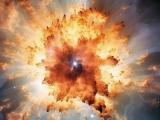
|
01/09/2023
NIRS3: the protostar that shows how giant stars grow The Institute of Astrophysics of Andalusia (IAA-CSIC) leads the sharpest analysis of this forming massive protostar, suggesting that it alternates recurrent episodes of accretion and ejection of material |
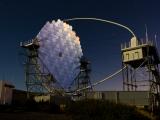
|
02/08/2023
Observations of the Crab Nebula confirm the outstanding performance of the first LST telescope at the CTA Observatory With more than sixty telescopes located in both hemispheres, the CTA Observatory will be the leading gamma-ray observatory for the next decades. The Institute of Astrophysics of Andalusia (IAA-CSIC) participates in the project and in the article on the performance of the LST-1 telescope, a milestone in the project |
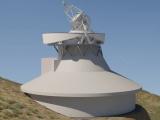
|
25/07/2023
The IAA-CSIC and the IAC participate in the creation of the European Solar Telescope Canary Foundation Nine institutions from seven European countries have today signed the deeds of this entity, which paves the way for the future construction of the European Solar Telescope (EST). One of the main goals of EST is to improve our understanding of the Sun by observing its magnetic fields in unprecedented detail |

|
11/07/2023 - 13/07/2023
https://www.granadacongresos.com/refsh?fbclid=IwAR0bl7jxUevZ_ohUT6wdE3CrxZ3gQATl… Granada |

|
24/10/2023 - 13:00
The Galactic Center seen with MeerKAT During its inauguration, the MeerKAT released, to date, the most detailed image of the centre of the Galaxy at L-band (1.28 GHz). Since then, the data have been exploited for various scientific research. One such exploitation was to produce a high resolution mosaic of the Galactic centre. From this mosaic came a catalogue of newly discovered unresolved point sources. Over 1500 sources were identified, of which 20 are steep spectrum point... Dr. Isabella Rammala |

|
07/11/2024 - 12:30
SO Colloquium: The tidal arms of open star clusters are much longer than thought, but more difficult to find The tidal arms of stellar clusters are an important tool for studying the clusters’ birth conditions, their evolution, coupling, and interaction with the Galactic potential. They also help understand how field stars populate the Milky Way. Thanks to Gaia, much progress has been accomplished in finding the tidal arms of open clusters. I will show here that such arms are much longer than previously observed, and that their identification requires... Dr. Henri Boffin |

|
28/06/2023
Emissions of several oceanic compounds cool the climate, but do not offset warming The Institute of Astrophysics of Andalusia (IAA-CSIC) is participating in a study that highlights the influence of a series of compounds emitted by the ocean on the Earth's climate. The scientific team, which stresses that this effect does not counteract the warming produced by human emissions, emphasises the need to include it in climate models to improve their predictions |
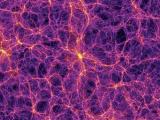
|
28/06/2023
Galaxies in the great cosmic voids grow more slowly than the rest of the universe The IAA-CSIC participates in a study that shows for the first time observationally that galaxies in the sparsely populated regions of the universe evolve more slowly than those in highly populated areas. The result is part of the CAVITY project, led by the University of Granada and developed at Calar Alto Observatory (CAHA) |

|
06/07/2023 - 13:00
La acreditación Severo Ochoa-IAA 2023-2027 To be provided Dr. Isabel Márquez |

|
19/10/2023 - 17:00
SO Webloquium: Feeding and Feedback: How to Make a Starburst and What that Means for the Host Galaxy The cycle of star formation governs the evolution of galaxies. In some local galaxies, the star formation rate in their centers are much higher than other normally star-forming galaxies and may be more similar to galaxies at earlier cosmic times. I present observational results from two archetypal nearby starburst galaxies: NGC253 and M82. First, I will discuss how gas flows to the center of NGC253 along its bar to fuel the extreme burst of... Dr. Rebecca C. Levy |

|
14/06/2023
The exoplanet LP 890-9 c, a laboratory to distinguish distant twins of Venus and Earth The Institute of Astrophysics of Andalusia (IAA-CSIC) participates in the development of a 3D global climate model of the extrasolar planet LP 890-9 c. These models are essential to analyze exoplanets similar to Earth, as well as to study their evolution |

|
23/11/2023 - 12:30
SO Colloquium: The transition between super-Earths and sub-Neptunes: Interior and atmosphere modelling of the low-mass planet population Low-mass exoplanets are showing a diversity in their densities, ranging from silicate-dominated super-Earths to volatile-rich sub-Neptunes. We have developed a coupled interior-atmosphere model that estimates the composition and interior structure of super-Earths and sub-Neptunes assuming water and CO2 atmospheres. The applications of the model include the homogenous analysis of a sample of multi-planetary systems, as well as the assessment of... Dr. Lorena Acuña |

|
26/10/2023 - 12:30
SO Colloquium: Multi-fluid solar chromosphere The solar chromosphere is the boundary layer between the interior and exterior of the Sun, routing the origins of the coronal heating. New large-aperture solar telescopes, such as the future 4-meter European Solar Telescope or American DKIST, have among their primary focus observations of chromospheric magnetic fields. The correct interpretation of solar data requires sophisticated theories. The solar chromosphere is made of strongly stratified... Dr. Elena Khomenko |

|
28/06/2023 - 12:30
Un universo de diversidad: historias LGTBI en el mundo de la razón y la ciencia El neurólogo Ben Barres, que murió hace unos pocos años, escribió un texto en Nature muy interesante sobre ciencia y género y en él decía: "The progress of science increasingly depends on the global community, but only 10% of the world’s population is male and caucasian. To paraphrase Martin Luther King, a first-class scientific enterprise cannot be built upon a foundation of second-class citizens." Él era transexual. El mundo de la ciencia,... Dr. Javier Armentia |

|
07/06/2023
The Spanish Foundation for Science and Technology (FECYT) grants the IAA-CSIC funding for four outreach projects The Institute of Astrophysics of Andalusia (IAA-CSIC) obtains a total of 122,000 euros in the Call for the promotion of Scientific, Technological and Innovation Culture 2022. The projects are committed to innovative and multidisciplinary formats, and include video, theater, improvisation and street outreach proposals |

|
28/09/2023 - 12:30
A VLTI view of Massive Young Stellar Objects (MYSOs) The formation of massive stars, objects with masses larger than 8 times solar, is central to both stellar astronomy and galactic evolution. In recent years, significant progress has been made in understanding the formation of high-mass young stellar objects (MYSOs; i.e. M∗ ≥ 8 M⊙, Lbol ≥ 5 x 103 L⊙. The latest observational and theoretical studies present evidence that HMYSOs are born in the same way as their low-mass counterparts, via disc... Dr. Maria Koutoulaki |

|
05/03/2024 - 12:30
SO colloquium: A new digitized age of SETI – interferometric commensal observations and machine learning The search for technosignatures - remotely observable indicators of advanced extraterrestrial life - addresses one of the most profound questions in science: are we alone in the universe as intelligent life? The Breakthrough Listen program is leading the most concerted search for extraterrestrial intelligence (SETI) effort to-date through radio and optical surveys of nearby stars, nearby galaxies and the Milky Way galactic plane, thus... Dr. Cherry Ng |

|
20/07/2023 - 12:30
Near-Infrared Observations of Clustered Massive Star Formation in Outflowing Region AFGL 5180 Massive stars are significant throughout the universe, as they impact their surroundings from the early stages of their formation until they die in the form of supernova. Observations in the near-infrared (NIR) of the bright and large-scale (~pc) jets which young stars ubiquitously produce during their formation process can place important constraints on the phenomenon of massive star formation. Here, we present a detailed NIR view of the star-... Sam Crowe |
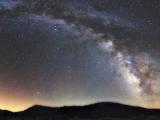
|
31/05/2023
The sky of the Granada Geopark, threatened by light pollution A study, developed by the Sky Quality Office of the Institute of Astrophysics of Andalusia (IAA-CSIC), reveals a deterioration of the Geopark sky, as well as the need to implement measures to preserve night darkness |

|
06/06/2023 - 12:30
Aperture Masking Interferometry with the JWST In this talk, I will present how the aperture masking interferometric (AMI) mode of the JWST works. I will describe the main characteristics of this mode. In particular, I will show some of the advantages of the mode complementary to standard imaging and coronagraphic observations. I will also introduce the basic principles of the AMI data analysis, including the extraction of the interferometric observables and their interpretation with... Dr. Joel Sanchez Bermudez |

|
13/07/2023 - 11:00
Solar Orbiter: An example of an international collaboration Solar Orbiter is a space mission of international collaboration between ESA (European Space Agency) and NASA. Solar Orbiter was launched on February 9th 2020 from Cape Canaveral, FL onboard of an Atlas V 411 rocket. This event signified the success of the diplomatic, economical, technological, and scientific effort of many countries and two space agencies to achieve a common goal. The outcomes from this mission will aid to the scientific... Dr. Teresa Nieves Chinchilla |

|
24/05/2023 - 26/05/2023
https://sites.google.com/view/qftcsworkshop2023/home Granada |

|
17/05/2023
The first radio detection of a type Ia supernova sheds light, after decades of debate, on the origin of these explosions These bursts, which show a similar luminosity in almost all cases, are used to measure distances in the universe or to study dark energy. The study, in which the Institute de Astrophysics de Andalusia (IAA-CSIC) participates, shows that the explosion occurred in a double star system in which a white dwarf stole material from its solar-type companion |
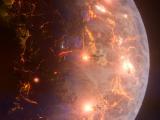
|
17/05/2023
A terrestrial-type planet found that could be covered with volcanoes The Institute of Astrophysics of Andalusia (IAA-CSIC) is participating in the discovery of a third planet around the nearby star LP791-18. Slightly larger than our own, its gravitational interaction with the most massive planet in the system could generate intense volcanic activity |

|
15/05/2023 - 19/05/2023
https://www.granadacongresos.com/els2023 Almuñecar |